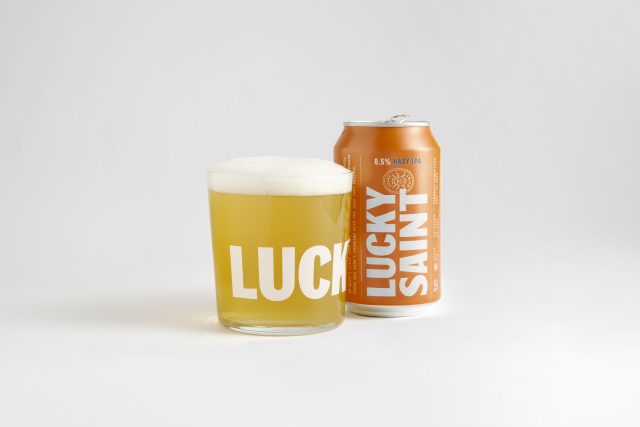This website uses cookies so that we can provide you with the best user experience possible. Cookie information is stored in your browser and performs functions such as recognising you when you return to our website and helping our team to understand which sections of the website you find most interesting and useful.
Is Lucky Saint’s new IPA the go-to alcohol-free drink for beer fans?
Lucky Saint has released an alcohol-free hazy IPA to join its lager this week, a beer style anticipated to “bring more drinkers into the alcohol-free category”.

The beer launch, named Lucky Saint Alcohol-Free Superior Hazy IPA, has been two years in the making and has been brewed with Citra, Mosaic, and Simcoe hops and California ale yeast. Each can contains just 59 calories. But will it assist in expanding people’s repertoire? The jury is still out.
Speaking to the drinks business about the rise of alcohol-free beer, Lucky Saint founder Luke Boase revealed that people were the driver to creating these beers. Both the consumer desire that led to them existing in the first place as well as the dedicated team of people he works alongside who have helped turn that desire into a reality. Essentially, it is determination that has made this happen.
He said: “I wanted to build a brand that people were proud to order at the bar, and it seems to be resonating with people. Most importantly, we’ve got an amazing team which makes things happen every day.”
Healthier living
Boase told db how much he thinks people’s attitudes towards drinking alcohol have evolved and that we can expect to see more of this in the future. He explained how “all of this has coincided with a huge shift in attitudes to alcohol-free – hugely positive shift towards alcohol-free and moderation over the past five years”.
He observed how “more people than ever are moderating year-round – with a rise of great tasting alcohol-free drinks and a desire from people to lead healthier lifestyles, I’d expect that to increase in 2024.”
No- and low-alcohol drinks have been on the rise throughout the pandemic and beyond, and are projected to grow more than 30% by 2024, according to reports by IWSR Drinks Market Analysis, as consumers turn towards healthier living and conscious consumption.
According to reports from Novograd, “consumers are seeking moderation, not simply abstinence”, and a stronger focus on premiumisation is needed to push the category forward.
According to alcohol removal specialist BevZero, beer and cider currently dominate the category, accounting for 92% of all no- and low-alcohol products on the market, but depending upon how trends take shape, this could also change if the category does not innovate at the same pace as consumer demand.
Why hazy?
But why was a hazy IPA chosen as the second beer? Essentially, Boase admitted that the reason comes down to the fact that “it’s the next biggest segment after lager, and it’s the beer style that our customers and our consumers have been asking us for”. He added that he thinks “there is an opportunity to bring more drinkers into the alcohol-free category” and that this is a good vehicle to achieve that. As he pointed out: “The ambition was to brew an alcohol-free IPA that captures the magic of new world hops, balanced with exceptional body and the perfect level of bitterness.”
With Lucky Saint going into pubs and supermarkets, independent bottle shops might feel the brand has become rather ubiquitous, but as Boase explained “independent bottle shops have been the foundation for us since the very start – and are go-to places for consumers looking for high quality alcohol-free options” so this is why “Lucky Saint Hazy IPA will be available in independent bottle shops”.
In terms of building towards other beer styles, Boase told db that the focus is being put squarely on making a success of the styles it has before racing ahead. He highlighted how “lager is 80% of the world’s beer consumption” and so said he has “always believed that if you’re going to build a defining alcohol-free brand, it’s going to be with lager” but admitted that “it took five years for us from the launch of our lager to bring our IPA to market” so said he knows that “there’s a huge amount of work to make the Hazy IPA as successful as the lager, which will no doubt keep us busy for the foreseeable future”.
Positive impact
What does the future hold for the brand? Boase is fairly pragmatic and watchful when it comes to the alcohol-free beer category’s steady growth.
“While acceptance and understanding of the category has come a long way, the alcohol-free category is still in its infancy in the UK, especially when you compare it to the size of the category in many European countries,” he said, but revealed that he is still “really excited about how the government can help support the alcohol-free category with the recent consultation” and is “already seeing the hugely positive impact alcohol-free is having on people”.
According to Boase, “clearing up some of the confusion around the category will help accelerate that impact across the country” and yet agreed that “2023 was a big year” and yet he is still “excited for what’s in store heading into 2024”.
Related news
Stone Brewing to cease all international exports

